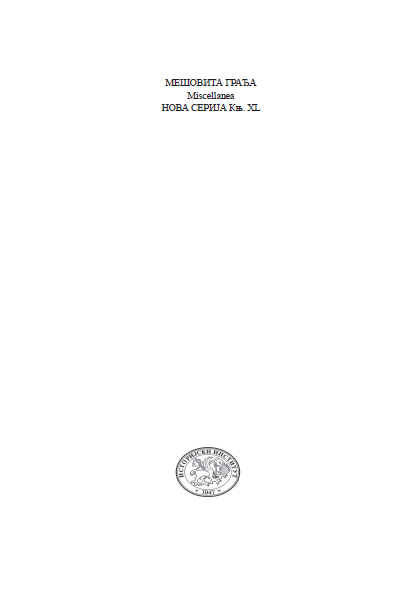ПРОБЛЕМ ИЗДАТАКА УПРАВЕ ДРЖАВНЕ ЕРГЕЛЕ У ЉУБИЧЕВУ ЗА ЧИНОВНИКЕ И СЛУЖИТЕЉЕ
THE PROBLEM OF EXPENSES OF THE ADMINISTRATION OF THE STATE STUD FARM IN LJUBIČEVO FOR CLERKS AND ATTENDANTS
Author(s): Gordana Petrović GarićSubject(s): Cultural history, Public Finances
Published by: Istorijski institut, Beograd
Keywords: Stud Farm; Ljubičevo; horses; Serbia
Summary/Abstract: Although natural resources in a significant part of Serbia were favourable for the advancement of horse breeding, this practice was poorly developed. In addition to their other activities, peasants engaged in horse breeding with insufficient knowledge and capital. The areas known for good horses and their numbers were Podrinje, Podunavlje, Požarevac and Timok – Kolubara, Jasenica, Lepenica, and the environs of Zaječar. The Serbian horse breed was created by breeding domestic heads with Oriental breeds. It featured a beautiful and regular anatomy, great endurance and liveliness and the durability of features. Its downsides were the fact that it developed slowly and was not large enough. To develop domestic horse breeding, the Serbian Government established the State Stud Farm, with the task to produce a better breed of studs in order to improve the domestic horse breeds. The Stud Farm was established in Dobričevo near Ćuprija in 1852, wherefrom it was transferred to Ljubičevo near Požarevac in 1860. A special department was established in Dobričevo in 1875. Upon establishment, the Stud Farm was administered by the Ministry of Interior. In 1859, it came under the remit of the Ministry of Finance, and in 1872 of the Ministry of the Military. After the Stud Farm was established, the population was granted the right to use the Farm’s horses for breeding upon paying a fee. In the second half of the 19th century, the domestic horse breed improved significantly owing to stud stations. Breeding stallions were sent there each year from the State Stud Farm in Ljubičevo. Such stations existed in each district, and in 1887 there were 22 of them. Total 111 studs were allocated to them at the time. The State Stud Farm earned revenue from stud taxes, garden, food and crops, livestock and stock breeding, rent, bull taxes, breeding taxes and the workshop. These direct revenues moved between 31,000 and 45,000 dinars. Apart from them, the Stud Farm had indirect revenues from the produced food and fodder. Expenditure related to the maintenance of stallion stations, salaries for staff and attendants, procurement of animals and current maintenance. In 1886, total 7,412.65 dinars per month were allocated for staff salaries. This cost equalled 85,711.80 dinars annually. These funds were significant and as they were provided from the budget, the Ministry of National Economy believed it was necessary to rationalise the workforce and use machinery to a higher extent. This was particularly important after the war year of 1885. Responding to the Ministry’s requests, the administrator of the Stud Farm Kosta Petrović stated that savings had already been made and that their even more rigorous enforcement could bring into question the very objective of founding the Stud Farm. The document prepared for print on this occasion also contains a list of clerks and attendants at the Stud Farm, with the names and monthly amounts of salaries for 147 of them. Almost a half of employees (seizi, rabaji and wards) earned between 24 and 40 dinars per month.
Journal: Мешовита грађа
- Issue Year: 2019
- Issue No: 40
- Page Range: 121-142
- Page Count: 22
- Language: Serbian

